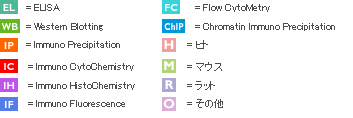
| Volume: | 20μg/80μL |
| Price: | inquiry |
| Antigen: | Pyrraline-HSA |
|---|---|
| GenBank ID: | – |
| Immunizing animal: | mouse |
| Purification: | ProteinG |
| Antibody subclass: | IgG1 |
| Application | |
|---|---|
| Cross React | |
| Others | Reaction of protein amino groups with glucose leads, through the early products such as a Schiff base and Amadori rearrangement products, to the formation of advanced glycation end products (AGEs). Recent immunological studies using anti-AGEs antibody (6D12) demonstrated the presence of AGEs-modified proteins in several human tissues: (ⅰ) human lens (nondiabetic and noncataractous), (ⅱ) renal proximal tubules in patients with diabetic nephropathy and chronic renal failure, (ⅲ) diabetic retina, (ⅳ) peripheral nerves of diabetic neuropathy, (ⅴ) atherosclerotic lesions of arterial walls, (ⅵ)β2-microglobulin forming amyloid fibrils in patients with hemodialysis-related amyloidosis, (ⅶ) senile plaques of patients with Alzheimer’s disease, (ⅷ) the peritoneum of CAPD patients, (ⅸ) skin elastin in actinic elastosis, and (ⅹ) ceriod/lipofuscin deposits. These results suggest a potential role of AGEs-modification in normal aging as well as age-enhanced disease processes. This antibody named as 6D12 has been used to demonstrate AGEs-modified proteins in these human tissues, indicating potential usefulness of this antibody for histochemical identification and biochemical quantification of AGEs-modified proteins. Pyrraline is one of the major Maillard compounds resulting from the reaction of glucose and amino coumpounds at slightly acidic pH. Using anti-pyrraline antibody, pyrraline was detected in sclerosed glomeruli from diabetic and normal old kidneys as well as in renal arteries with arteriosclerosis. Futhermore, it was detected in neurofibrillary tangles and senile plaques in brain tissue from patients with Alzheimer’s disease. |
| Reference |
|
| Collaborators | — |
—
How to Order
Please contact one of following international distributors.
- Cosmo Bio USA, Inc.
- E-mail : info@cosmobiousa.com
TEL : +1-760-431-4600
FAX : +1-760-431-4600
- Funakoshi Corporation
- E-mail : reagent@funakoshi.co.jp
TEL : +81-3-5684-1620
FAX : +81-3-5684-1775
- FUJIFILM Wako Pure Chemical Corporation
- E-mail : ffwk-labchem-tec@fujifilm.com
TEL : 0120-052-099 (only in Japan)
FAX : 0120-052-806 (only in Japan)
- Sceti K.K.
- E-mail : export@sceti.co.jp
TEL : +81-3-5510-2652
FAX : +81-3-5510-0133


